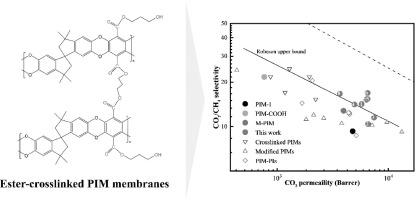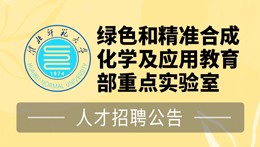Separation and Purification Technology ( IF 8.1 ) Pub Date : 2023-03-16 , DOI: 10.1016/j.seppur.2023.123623
Yongchao Sun , Jingfa Zhang , Hongjin Li , Fangxu Fan , Qizheng Zhao , Gaohong He , Canghai Ma

|
Polymers of intrinsic microporosity (PIMs) have seen a growing role in gas separation membranes. Further exploitation of gas separation performance of PIM membranes and overcoming their persistent challenge of plasticization are urgently demanded. To address these issues, exemplified PIM-1 is synthesized and hydrolyzed to form carboxylated PIM-COOH polymers, followed by esterification using propylene glycol to prepare monoesterified PIM, which is finally thermally ester-crosslinked at various temperatures and time. The 300 °C-8 h treated membranes exhibit a CO2 permeability of 7421 Barrer, with a CO2/CH4 and CO2/N2 selectivity of 11.5 and 19.2, respectively, considerably exceeding the 2008 Robeson upper bounds. Furthermore, the crosslinked membranes demonstrate significantly enhanced CO2 plasticization resistance up to 42 bar, compared with uncrosslinked ones. It is the first time of reporting ester-crosslinking of carboxylated PIM-1 with both higher gas permeability and selectivity than PIM-1, using a much milder crosslinking temperature than other techniques, such as decarboxylated crosslinking. The design principle of this work paves the way for preparing high-performance and plasticization-resistant PIM membranes with promises for energy-efficient gas separations.
中文翻译:

用于 CO2 分离的具有增强塑化抗性的本征微孔膜的酯交联聚合物
固有微孔聚合物 (PIM) 在气体分离膜中的作用越来越大。迫切需要进一步开发 PIM 膜的气体分离性能并克服其持续存在的塑化挑战。为了解决这些问题,示例性的 PIM-1 被合成并水解形成羧化 PIM-COOH 聚合物,然后使用丙二醇酯化制备单酯化 PIM,最后在不同温度和时间下进行热酯交联。经过 300 °C-8 h 处理的膜表现出 7421 Barrer 的 CO 2渗透率,CO 2 /CH 4和 CO 2 /N 2选择性分别为 11.5 和 19.2,大大超过了 2008 年 Robeson 的上限。此外,与未交联的膜相比,交联的膜表现出显着增强的 CO 2增塑抗性,最高可达 42 巴。这是首次报道羧化 PIM-1 的酯交联,具有比 PIM-1 更高的透气性和选择性,使用比其他技术(如脱羧交联)温和得多的交联温度。这项工作的设计原理为制备高性能和抗塑化 PIM 膜铺平了道路,有望实现节能气体分离。































 京公网安备 11010802027423号
京公网安备 11010802027423号